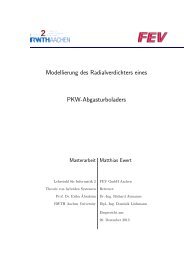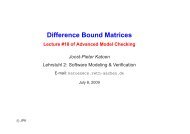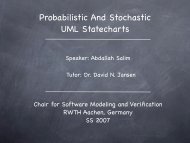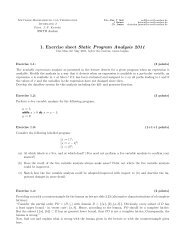Research Projects - Software Modeling and Verification - RWTH ...
Research Projects - Software Modeling and Verification - RWTH ...
Research Projects - Software Modeling and Verification - RWTH ...
Create successful ePaper yourself
Turn your PDF publications into a flip-book with our unique Google optimized e-Paper software.
Simulations, carried out with the MoDeST/Möbius tool set, show that comparing to the simple<br />
slotted Aloha protocol, the new GMAC has indeed a significant beneficial influence on<br />
energy consumption for all the three networks. However, it also delayed message propagation.<br />
Furthermore, we discovered that GMAC with constant sending power may cause a lot of interference<br />
in dense area, <strong>and</strong> in sparse area, nodes may disconnect to each other. Hence we<br />
proposed a dynamic energy scheduling schema, so that a node can regulate its sending power<br />
with respect to its current number of neighbours. Simulation results show that for Gaussian<br />
networks, our dynamic power management not only improved energy consumption, but also<br />
accelerated message propagation.<br />
Our current research aims at gathering evidence that the SINR model is in fact realistic<br />
enough to allow the derivation of reliable measures for wireless sensor networks using simulation.<br />
For that we try to explain measurement data from CHESS by means of the SINR<br />
model.<br />
Formal Models of Microcontroller Systems<br />
Th. Noll,<br />
J. Brauer (Chair of <strong>Software</strong> for Embedded Systems)<br />
Embedded systems usually operate in uncertain environments, giving rise to a high degree of<br />
nondeterminism in the corresponding formal models. Moreover they generally h<strong>and</strong>le data<br />
spaces whose sizes grow with the memory <strong>and</strong> the word length of the respective microcontroller<br />
architectures. This, together with other effects, leads to the well-known state-space explosion<br />
problem, meaning that the models of those systems grow exponentially in size as the<br />
parameter values increase. Careful h<strong>and</strong>ling of both nondeterminism <strong>and</strong> large data spaces is<br />
therefore crucial for obtaining efficient methods <strong>and</strong> tools for analysis <strong>and</strong> verification.<br />
The goal of this project, carried out in close cooperation with the Embedded <strong>Software</strong> Laboratory<br />
of our department, is to develop abstraction techniques to tackle this problem. With regard<br />
to control structures, a technique for refining loops in microcontroller programs has been<br />
developed. It is based on abstract interpretation using octagons <strong>and</strong> affine equalities in order<br />
to identify infeasible sequences of loop iterations. Our approach naturally integrates wraparound<br />
arithmetic during the generation of abstractions. Abstract interpreters operating on a<br />
refined control structure then typically derive strengthened program invariants without having<br />
to rely on complicated domain constructions.<br />
With regard to data spaces, activities have been concentrating on static analysis methods for<br />
approximating the possible run-time values of data values. For this purpose, intervals have<br />
successfully been used for decades. Binary code on microcontroller platforms, however, is<br />
different from high-level code in that data is frequently altered using bit-wise operations <strong>and</strong><br />
that the results of operations often depend on the hardware configuration. We therefore came<br />
up with a method that combines word- <strong>and</strong> bit-level interval analysis <strong>and</strong> that integrates a<br />
hardware model by means of abstract interpretation in order to h<strong>and</strong>le these peculiarities.<br />
Both techniques have successfully been applied to a suite of benchmark examples.












